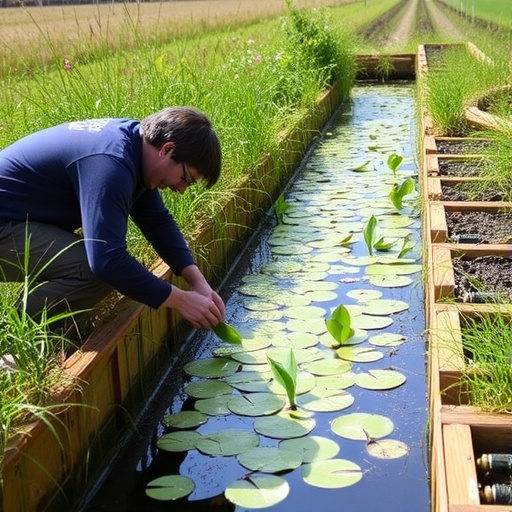In the realm of environmental science and ecological restoration, the remediation of heavy metal contaminated lands has emerged as a critical topic of study. Heavy metals, due to industrial activities and waste disposal, have infiltrated soil and water systems, presenting severe risks to public health and ecosystems. Recent research spearheaded by Farid et al. sheds light on innovative strategies for enhancing the phytoextraction process in constructed wetlands, particularly through the use of organic chelators. This study offers compelling insights into the optimization of heavy metal remediation, potentially reshaping current methodologies.
Phytoextraction is a bioremediation technology that utilizes plants to absorb contaminants from the soil, effectively purifying the land. The process relies on the natural ability of certain plants to uptake heavy metals through their root systems. However, the efficiency of this method often fluctuates depending on the metal type, plant species, soil conditions, and the bioavailability of the metals present. Farid and his team focused on addressing one of the significant limitations of phytoextraction: the bioavailability of heavy metals.
To improve the efficiency of phytoextraction, the researchers introduced organic chelators into the constructed wetlands. Chelators are substances that can bind to metal ions, altering their chemical state, and increasing their mobility in the soil. The study emphasizes that by adding organic chelators, the binding strength between the metals and soil particles diminishes, allowing plants to absorb more contaminants. This method exemplifies a sustainable approach to metal extraction that reduces soil toxicity and promotes ecological health.
In their experimental setup, Farid et al. utilized various types of constructed wetlands, each amended with different organic chelators. The wetlands served as a controlled environment where the interplay between heavy metal uptake by plants and the chemical transformation induced by the chelators could be monitored meticulously. Observations indicated that organic chelators not only enhanced metal uptake but also improved plant growth and overall health, creating a conducive environment for effective remediation.
The physiological impact of these amendments on plant species selected for the study was notable. Researchers monitored specific parameters such as root morphology, biomass accumulation, and metal concentration within plant tissues over time. Their findings revealed that certain combinations of organic chelators and wetland plants led to significantly increased phytoextraction rates. This suggests a synergistic effect where chelators not only facilitate metal availability but also enhance plant vigor and resilience in contaminated environments.
In addition to the biological factors, the researchers also analyzed the chemical dynamics within the constructed wetlands under varying pH levels and nutrient availability. By optimizing these conditions, the study underscores the importance of integrating chemical and biological strategies for effective heavy metal removal. This holistic approach paves the way for developing tailored remediation strategies that account for site-specific conditions and plant characteristics.
The implications of these findings extend beyond theoretical applications. The ability to refine the phytoextraction process through the use of organic chelators suggests that policy makers and land management organizations could implement these strategies in actual contaminated sites. This could lead to quicker and more efficient restoration of these lands, which often pose threats to human health and biodiversity.
Moreover, the research aligns with a growing trend in sustainable environmental practices, advocating for the utilization of natural processes in combatting pollution. With global efforts directed towards reducing chemical usage and mitigating environmental impact, phytoextraction represents a viable path forward. The potential economic and ecological benefits of utilizing constructed wetlands for remediation are significant, offering solutions that harmonize with natural ecosystems rather than disrupting them.
As cities and industries continue to expand, the prevalence of contaminated lands will likely rise. Therefore, the insights provided by Farid et al. are timely and essential for addressing future environmental challenges. By expanding our understanding of how to optimize phytoextraction with organic amendments, researchers can contribute to a more sustainable future where contaminated environments can be revitalized effectively.
In conclusion, this groundbreaking study by Farid and colleagues stands as a testament to the potential of interdisciplinary approaches in tackling environmental pollution. Through rigorous research and practical applications, the field of phytoextraction is poised for transformative advancements, with organic chelators playing a pivotal role in enhancing the efficiency of heavy metal remediation in constructed wetlands. The findings articulate a clear message: with innovation and science as guiding forces, reclaiming polluted landscapes is indeed within our grasp.
Ultimately, as the dialogue surrounding environmental sustainability continues, the research opens pathways for further exploration in organic amendments and other bioremediation technologies. The need for ongoing studies in this domain cannot be overstated, as the challenges posed by heavy metal contamination will require continuous technological and biological innovations to ensure a healthier planet for future generations.
Subject of Research: Optimization of heavy metal phytoextraction in constructed wetlands using organic chelators.
Article Title: Monitoring and optimization of heavy metal phytoextraction in constructed wetlands amended with organic chelators.
Article References:
Farid, M., Mussarat, A., Zubair, M. et al. Monitoring and optimization of heavy metal phytoextraction in constructed wetlands amended with organic chelators.
Environ Monit Assess 197, 1363 (2025). https://doi.org/10.1007/s10661-025-14801-0
Image Credits: AI Generated
DOI: https://doi.org/10.1007/s10661-025-14801-0
Keywords: Phytoextraction, heavy metals, constructed wetlands, organic chelators, bioremediation, environmental science.




